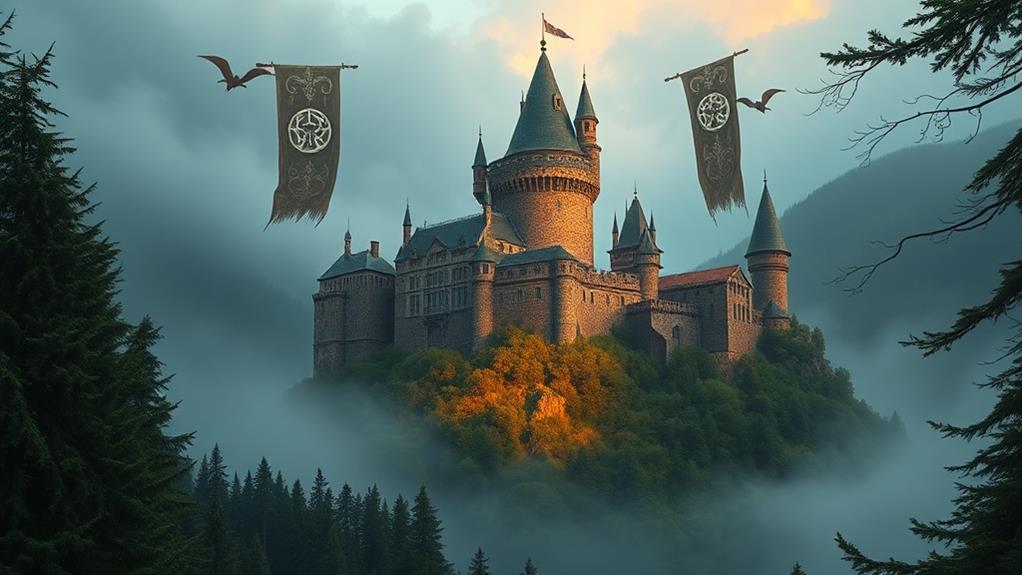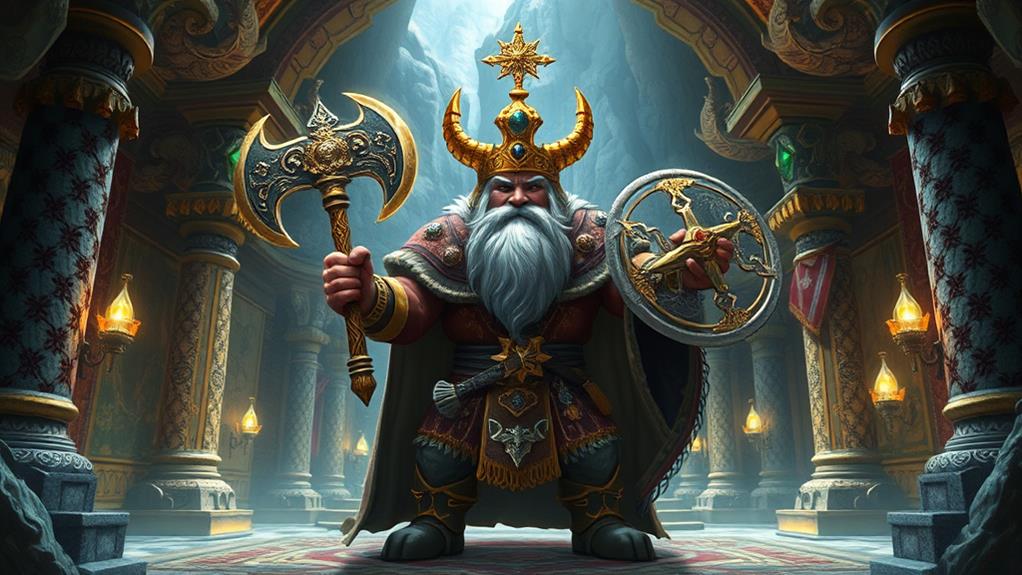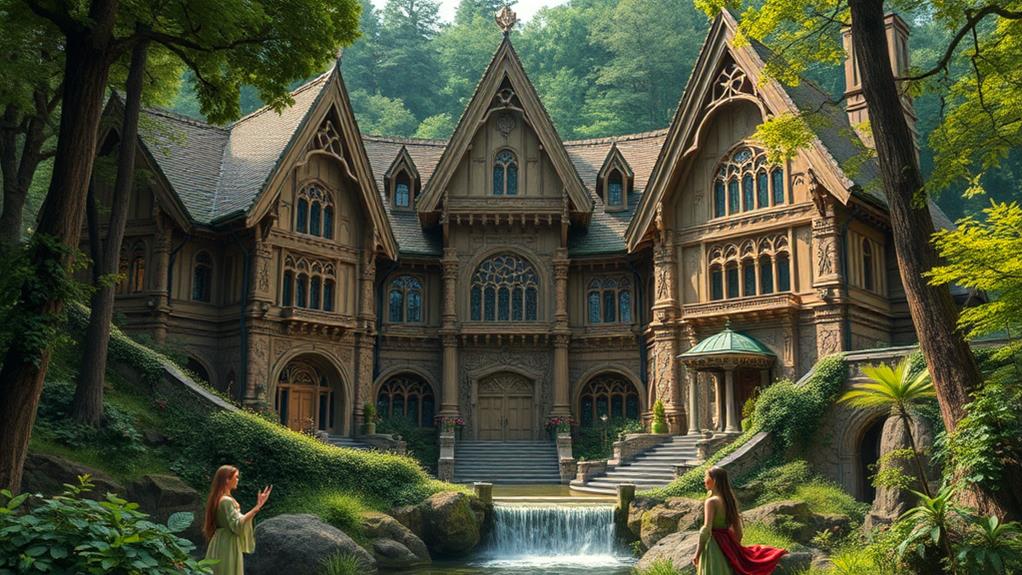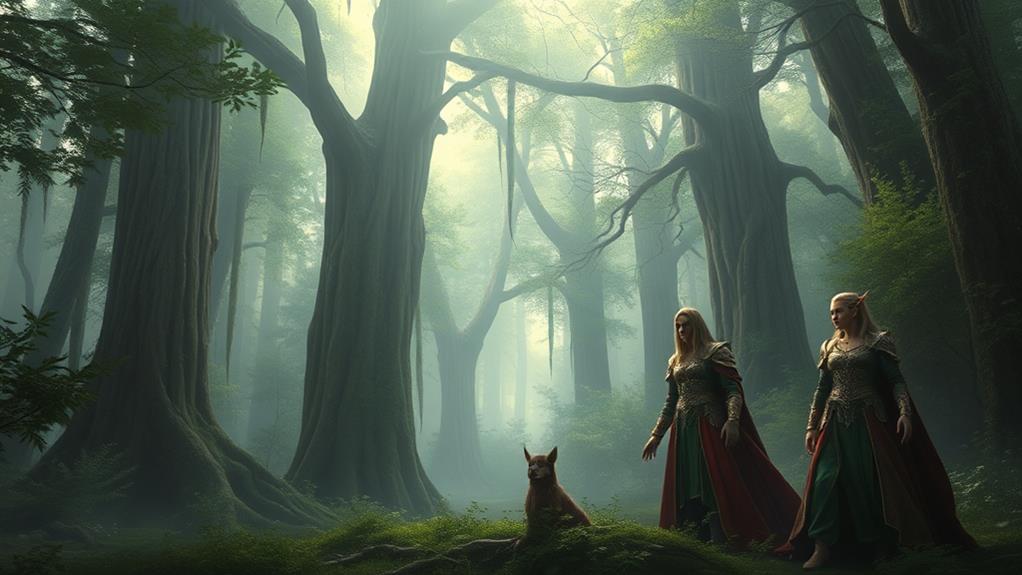
In Tolkien's world, you'll uncover royal lineages that span from the drowned kingdom of Númenor to the fragmented thrones of Arnor. Witness Gondor's dynastic struggles and the heroic tales of Rohan's kings like Théoden. Explore the reclaimed reign of the Dwarven kings of Erebor and the serene leadership of Elrond in Rivendell. The Shire has its own story with the Thain's gradual evolution. With Aragorn's unification of Gondor and Arnor, Middle-earth's history is rich with conquest and unity. There's an entire tapestry of epic legacies and legendary battles waiting for you to explore further.
Númenor: The Rise and Fall

Journeying through the history of Númenor, you'll uncover a tale marked by both grandeur and tragedy. Established as a gift from the Valar to the Edain, Númenor rose as a beacon of human achievement. Its people, the Númenóreans, possessed long life and exceptional wisdom, thanks to their close ties with the Elves. The island itself was a paradise, with fertile lands and stunning architecture, reflecting their advanced civilization.
Yet, despite their prosperity, the seeds of Númenor's downfall were sown by ambition and pride. Over time, the Númenóreans became envious of the Elves' immortality and sought to challenge the divine order. This hubris led them to break the Ban of the Valar, setting sail on voyages to Middle-earth and establishing dominions there. Their insatiable thirst for power culminated in the reign of Ar-Pharazôn, who dared to invade Aman, seeking eternal life.
The Valar, in response, called upon Eru Ilúvatar, who reshaped the world, drowning Númenor beneath the waves. Only a few faithful escaped, led by Elendil, who carried on their legacy in Middle-earth. Consequently, Númenor's rise and fall serve as a poignant reminder of the peril of unchecked ambition.
Gondor's Dynastic Struggles
As the remnants of Númenor found new hope in Middle-earth, they established the kingdom of Gondor, which would later face its own internal turmoil. You see, Gondor's early years were marked by stability under the rule of Isildur and his descendants, but this peace didn't last. Dynastic struggles erupted, especially during the Kin-strife, a bloody civil war in the Third Age.
The Kin-strife began when King Valacar's mixed lineage, through marriage to a non-Dúnedain woman, was questioned. His son, Eldacar, faced rebellion led by Castamir, who claimed pure Númenórean blood. Castamir's forces seized the throne, leading to a decade of brutal conflict. You'd witness cities burning and families torn apart until Eldacar finally reclaimed his crown, executing Castamir and restoring order.
However, Gondor's troubles didn't end there. The Great Plague and constant assaults from Mordor weakened the kingdom's defenses. Later, the line of kings failed with the death of Eärnur, who left no heir. The Stewards took over, maintaining the domain but never claiming the throne. This period of uncertainty and fragmented leadership left Gondor vulnerable until Aragorn's return in the War of the Ring. In these times of strife, the strength and resilience of Gondor's people shone through.
Arnor's Fragmented Thrones

You might find it surprising that while Gondor was grappling with its internal struggles, the northern kingdom of Arnor faced its own set of challenges. Arnor, once a unified and strong domain, gradually succumbed to internal divisions. After the death of King Eärendur, the kingdom split into three smaller domains: Arthedain, Cardolan, and Rhudaur. This fragmentation weakened Arnor's ability to defend itself against external threats and internal discord.
You can trace the root of Arnor's fragmentation to disputes over succession. Eärendur's sons couldn't agree on a single heir, leading to the fracturing of the kingdom. Arthedain retained the capital, Annúminas, and the line of Isildur, maintaining a semblance of continuity. However, Rhudaur and Cardolan struggled with internal strife and external pressures, especially from Angmar, the Witch-king's domain.
As years passed, Arthedain remained the strongest of the three, but it was perpetually besieged by the forces of Angmar. Despite attempts at unity, the remnants of Arnor couldn't stand against the Witch-king's relentless attacks. Eventually, Arthedain fell, and the once-great kingdom of Arnor became a memory, its legacy surviving only in the scattered Dúnedain Rangers.
Rohan's Royal Heritage
Rohan's Royal Heritage traces its origins to the noble lineage of the Éothéod, a valiant people who migrated south to the lands of Calenardhon. Under the leadership of Eorl the Young, the Éothéod answered Gondor's call for aid and were rewarded with the land that would become Rohan. Eorl became the first King of the Mark, establishing a legacy of courage and loyalty.
As you explore Rohan's history, you'll see a lineage marked by resilience and steadfast leadership. Helm Hammerhand, the ninth King, is legendary for his defense during the Long Winter, a proof to Rohan's enduring spirit. The line continued with rulers who valiantly defended their domain against orcs, Dunlendings, and other threats.
In more recent history, Théoden, the seventeenth King, exemplified Rohan's martial prowess. Despite initial despair, he rallied his people at the Battle of Helm's Deep and later led the charge at the Battle of the Pelennor Fields, a defining moment in the War of the Ring.
Rohan's royal heritage is a saga of bravery, honor, and unwavering dedication to their land and allies. Each king's story adds to the rich tapestry of Middle-earth's history.
Dwarven Kings of Erebor

Erebor's grandeur stands as a tribute to the legacy of its Dwarven kings, whose rule shaped the fate of the Lonely Mountain. When you think of Erebor, you can't ignore the indelible mark left by King Thror, the proud monarch who led his people during a time of prosperity and amassed unimaginable wealth. His reign, however, was tragically cut short by the dragon Smaug, who seized the mountain and its treasures, forcing the Dwarves into exile.
Years later, Thror's grandson, Thorin Oakenshield, set out on a daring quest to reclaim Erebor. With the help of Bilbo Baggins and a company of brave Dwarves, Thorin succeeded in ousting Smaug, though his victory was bittersweet. Thorin's tragic fall in the Battle of the Five Armies underscored the heavy price of reclaiming their homeland.
Following Thorin's death, Dain Ironfoot, his cousin, ascended the throne. Under Dain's wise and resilient leadership, Erebor flourished once more, restoring the kingdom to its former glory. As you explore into the history of Erebor's kings, you see a legacy marked by resilience, courage, and an unyielding spirit that has withstood the test of time.
Elven Lords of Lothlórien
After the tales of Erebor's Dwarven kings, let's journey to the ethereal domain of Lothlórien, where the Elven lords have woven their own rich tapestry of history. Nestled within the Golden Wood, Lothlórien is ruled by the wise and powerful Galadriel and her husband Celeborn. These two figures stand as paragons of Elven beauty, wisdom, and strength.
Galadriel, one of the mightiest Elves remaining in Middle-earth, bears Nenya, the Ring of Water. Her foresight and power protect Lothlórien, creating an almost timeless sanctuary. Celeborn, though lesser-known compared to his illustrious wife, is a formidable leader and warrior, respected by all who know him.
Together, they've safeguarded Lothlórien from countless threats, including the encroaching darkness of Sauron. Galadriel's wisdom and Celeborn's strategic acumen have made their kingdom a bastion of hope and beauty amidst the chaos of Middle-earth. Their rule represents the pinnacle of Elven grace and resilience.
As you wander through the golden mallorn trees, you can feel their presence, an affirmation to their enduring legacy. It's a living, breathing piece of history that continues to inspire and awe all who enter.
Rivendell's Elven Lineage

One cannot explore into the rich tapestry of Middle-earth without pausing to appreciate Rivendell's illustrious Elven lineage. Rivendell, also known as Imladris, stands as a beacon of wisdom, refuge, and history, all thanks to its founder and leader, Elrond Half-elven. Elrond's lineage is a blend of powerful ancestries, being the son of Eärendil and Elwing, and descended from both Elves and Men. His heritage links him to some of the most significant figures in Tolkien's legendarium, including Lúthien, Beren, and even Melian the Maia.
Elrond's leadership in Rivendell isn't just about bloodline; it's about his role as a protector and guide. Under his stewardship, Rivendell became a sanctuary for those seeking knowledge and respite from the turmoil of Middle-earth. It's here that the Council of Elrond convened, marking a pivotal moment in the quest to destroy the One Ring.
Rivendell's lineage extends through Elrond's children, Arwen, Elladan, and Elrohir, whose choices further intertwine the fates of Elves and Men. This lineage underscores Rivendell's significance, not just as a place, but as a living tribute to the enduring legacy of Elvenkind.
The Shire's Thain Succession
The Shire's Thain Succession is a fascinating aspect of Hobbit society, reflecting their unique blend of tradition and governance. Unlike the grand monarchies of Men or the ancient lineages of Elves, the Hobbits have a more modest and practical approach to leadership. The Thain is not a king but a respected leader, chosen from among the prominent families of the Shire. Initially, the title of Thain was held by the Oldbucks, but it passed to the Tooks when Bucca of the Marish became the first Thain of the Shire.
You'll find that the Thain's role is largely ceremonial, focused on maintaining peace and order rather than wielding absolute power. The succession typically follows a hereditary pattern, with the title passed down to the eldest son. However, if no suitable heir exists, the Shire's assembly of family heads, known as the Shire-moot, can elect a new Thain from another family. This guarantees stability and continuity while preventing any single family from gaining too much power.
The Woodland Realm's Sovereigns

While the Thain's role in the Shire is mostly ceremonial, leadership in other parts of Middle-earth takes on different forms. In the Woodland domain, the Elvenking's authority is absolute. You'll find Thranduil, the domain's most notable sovereign, ruling from his underground palace in Northern Mirkwood. He's not just a figurehead; he commands respect and wields substantial power.
Thranduil's leadership reflects the Elves' deep connection to their forest home. He's a warrior king, having fought in the Battle of Five Armies and earlier conflicts. His decisions impact the entire domain, from diplomatic relations with neighboring races to maintaining the forest's delicate balance. You'll see his influence in every aspect of Woodland life, from the intricate architecture of his halls to the disciplined ranks of his soldiers.
Under Thranduil's rule, the Woodland domain remains a bastion of Elven culture and resilience. He's protective of his people, wary of outsiders, and deeply committed to preserving their way of life. This sovereignty contrasts sharply with the Shire's more relaxed governance, showing how diverse leadership styles shape Middle-earth's many regions. Thranduil's reign exemplifies the Elves' enduring strength and wisdom in a world often fraught with peril.
The Reunited Kingdom's Monarchs
Forging a new era in Middle-earth, the Reunited Kingdom's monarchs stand as symbols of unity and renewal. After the War of the Ring, Aragorn II Elessar ascended the throne, uniting Gondor and Arnor under his leadership. His reign marked the beginning of the Fourth Age, an era of peace and prosperity. You can see Aragorn's impact in the rebuilding of cities, the re-establishment of ancient alliances, and the promotion of justice and fairness throughout the lands.
Aragorn's legacy didn't stop with him. His son, Eldarion, inherited the throne and continued his father's work. Eldarion guaranteed the stability of the Reunited Kingdom, maintaining strong ties with the Elves and Dwarves. Under his rule, the domain flourished further, with advancements in art, culture, and infrastructure.
As a reader, you should recognize the importance of these monarchs in Tolkien's world. Their dedication to unity and renewal reshaped Middle-earth, transforming it into a beacon of hope and resilience. The Reunited Kingdom's monarchs exemplify the strength found in unity and the enduring power of rightful leadership, leaving an indelible mark on the history of Middle-earth.
At a Glance
As you explore the intricate royal lineages and kingdom conquests in Tolkien's world, one fascinating statistic stands out: Númenor's rulers spanned over 3,000 years before its downfall. This longevity highlights the epic scale and depth of Tolkien's mythology. From Gondor's dynastic struggles to the Shire's Thain succession, each lineage weaves a rich tapestry of power, legacy, and lore. Dive deeper into these histories, and you'll uncover the timeless allure of Middle-earth's sovereign tales.






